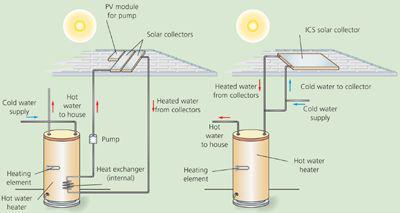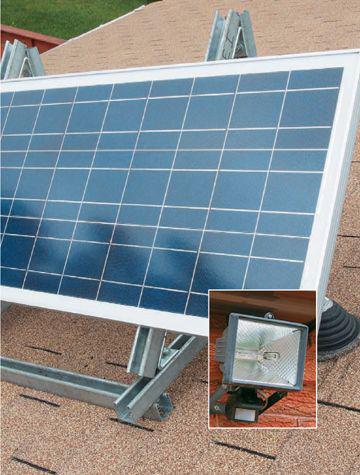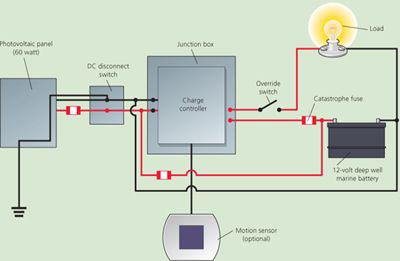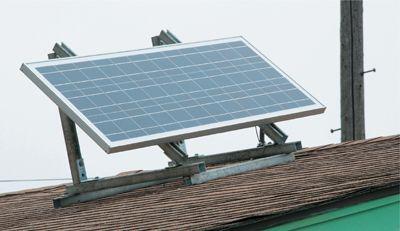Authors: Betsy Matheson
Tags: #Non-Fiction
DIY Projects for the Self-Sufficient Homeowner: 25 Ways to Build a Self-Reliant Lifestyle (37 page)

Lifetime technical support
Another thing to be aware of when comparing various providers’ quotes, and in talking to other customers, is the actual output of a panel or array as opposed to its STC (or “name plate”) wattage rating. Industry sources say the actual useable power of a system is typically about 75% of the rated power. This means that if your home needs three kilowatts of power your system should be rated for four kilowatts.
Solar for Hot Water & Heating
The science behind solar water heating is quite simple: If you’ve ever turned on a garden hose that’s been left out in the sun (only to get extremely hot water when you expected cold), you pretty much get how it works. In a basic solar hot water system, water or an antifreeze fluid is circulated through rooftop collector units, then down into the house (or swimming pool) where it feeds a system to supply domestic hot water or to supplement space heating equipment.
Solar hot water systems are used in many different climates and are inexpensive and reliable enough to yield relatively quick financial returns in addition to long-term environmental benefits. For most homes, the solar system is used in conjunction with conventional heating equipment, such as a hot water heater or boiler, providing preheated water to the system to reduce its net energy use. On average, solar heaters for domestic hot water are most cost-effective when they supply around 70% of a home’s hot water. Solar systems supplementing heating equipment are most cost-effective when designed to offset 40% to 80% of the home’s annual demand.
Types of Hot Water Systems
The basic setup of a solar hot water system includes one or more collectors, a storage tank, various control devices, and a network of piping. Indirect systems circulate the same water or fluid through a continuous pipe loop and transfer heat via a heat exchanger. Direct systems run fresh water through the collector’s piping and into the home for direct use.
Systems are also defined by their means of circulation. Active heaters use a pump to move the water or fluid mechanically; passive heaters move water without pumps, usually through the natural process of thermosyphoning: As the water in the collector heats up, it flows into a storage tank while cold water refills the collector tubes.
Solar heaters for domestic hot water may include a separate storage tank that feeds preheated water into a standard tank-style hot water heater or a tankless on-demand heater. The water heater can then boost the temperature of the water as needed. In other systems, solar-heated water is fed directly into a hot water tank, which typically contains its own conventional heat source.

Two systems for
domestic hot water: An indirect, active system (left) heats water via a heat exchanger inside a hot water tank and uses a pump to circulate fluid to and from the solar collectors. A direct, passive system (right) heats the same water that gets used in the house and relies on natural processes for circulation.

A self-contained electrical circuit with dedicated loads, usually
12-volt light fixtures, is one of the most useful solar amenities you can install. A standalone system is not tied into your power grid, which greatly reduces the danger of installing the components yourself. Plus, the fact that your light fixtures are independent of the main power source means that even during a power outage you will have functioning emergency and security lights.

This 60-watt solar panel
is mounted on a garage roof and powers a self-contained home security lighting system. Not only does this save energy costs, it keeps the security lights working even during power outages.
Installing a single solar-powered circuit is relatively simple, but don’t take the dangers for granted. Your work will require permits and inspections in most jurisdictions, and you can’t expect to pass if the work is not done to the exact specifications required.
Solar panels that convert the sun’s energy into electricity are called photovoltaic (PV) panels, and they produce direct current (DC) power. PV solar panel systems can be small and designed to accomplish a specific task, or they can be large enough to provide power or supplementary power to an entire family’s home. Before you make the leap into a large system, it’s a good idea to familiarize yourself with the mechanics of solar power. The small system demonstrated in this project is relatively simple and is a great first step into the world of solar. The fact that the collector, battery, and lights are a standalone system makes this a very easy project to accomplish. By contrast,
installing panels that provide direct supplementary power through your main electrical service panel is a difficult wiring job that should be done by professional electricians only.
DC Light Circuit Schematic

TOOLS & MATERIALS
Tape measure
Drill/driver with bits
Caulk gun
Crimping tool
Wiring tools
Metal-cutting saw
Photovoltaic panel (50 to 80 watts)
Charge controller
Catastrophe fuse
Battery sized for 3-day autonomy
Battery case
Battery cables
12-volt LED lights including motionsensor light
Socket wrench
20 ft. Unistrut 1-7/8" thick U-channel (See Resources,
page 158
)
(4) 45° Unistrut connectors
(2) 90° Unistrut angle brackets
(4) Unistrut hold-down clamps
(12) 3/8" spring nuts
(12) 3/8 × 1" hex-head bolts with washers
DC-rated disconnect or double-throw snap switch
6 ft. length of 1/2" liquid-tight flexible metallic conduit
(2) 1/2" liquid-tight connectors
(2) Lay-in grounding lugs
(2) Insulated terminal bars to accept one 2-gauge wire and four 12-gauge wires
(2) Cord cap connectors for 1/2" cable
1/2" ground rod and clamp
Copper wire (6-, 12-gauge)
Green ground screws
1/2" flexible metallic conduit or Greenfield
1/2" Greenfield connectors
(4) 11/16" junction boxes with covers
(4) square boxes with covers
6 × 6" junction box with cover
14/2 UF wire
1/4 × 20 nuts and bolts with lock washers
Roof flashing boot
Roof cement
Silicon caulk
 Installing an Off-the-Grid Solar Lighting System
Installing an Off-the-Grid Solar Lighting SystemBefore you begin installing a standalone solar-powered circuit, you’ll need to make some basic determinations. The panel location is chief among these questions. Position the solar panel where it will receive the greatest amount of sunlight for the longest period of time each day—typically the south-facing side of a roof or wall. For a circuit with a battery reserve that powers two to four 12-volt lights, a collection panel rated between 40 and 80 watts of output should suffice. These panels can range from $200 to $600 in price, depending on the output and the overall quality.
Mounting the Panel
The photovoltaic panel must be securely mounted on a permanent stand and then connected via wires to the power distribution hardware inside the structure. Although some low-wattage panels come with a mounting stand, on larger PV panels you’ll need to construct the mounting structure yourself using metal U-channels or other materials. The stand seen in this project is constructed with channels and fittings to secure the panel in a south-facing position on a garage roof. The structure is made with Unistrut brand metal channel and hardware (see Resources,
page 158
).

